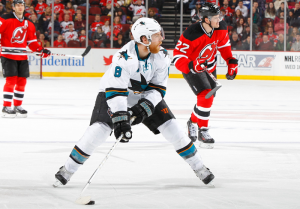
When the 2013-2014 NHL season began, the plan for the San Jose Sharks’ line combinations was to utilize their center depth advantage on opposing teams. Injuries and chemistry issues forced the Sharks to abandon that approach halfway through the season and surprisingly, the newly formed lines have created chemistry and addition depth.
Once the Olympic break finished, the Sharks were finally healthy enough to field a lineup close to the one GM Doug Wilson had envisioned at the beginning of the season.
Forwards Raffi Torres and Adam Burish hadn’t played in a single game all season and star center Logan Couture had been out since early January.
All three players have had a significant impact, not just on the score sheet but by allowing everyone else to slot into more comfortable roles.
Couture has five goals and 10 points since the break and Torres had five points in five games.
Wilson felt that the addition of those players worked similar to acquiring new players at the trade deadline and decided to stay quiet for that reason. The limited salary cap space also must have played a role.
Few teams can match up with the Sharks’ top three centers in Joe Thornton, Logan Couture and Joe Pavelski. When the team ran this lineup in the past it’s been successful.
The problem is the Sharks rarely have the wing depth to field six good wingers to play with each of these talented centers. Instead one (usually Pavelski) is forced into a top six role on the wing.
When Tomas Hertl suffered a knee injury in mid-December, Joe Pavelski was put on the top line with Joe Thornton and Brent Burns and immediately caught fire. Since the move, Pavelski scored 21 of his 34 goals.
During that stretch, that line carried the Sharks’ offense while the team battled an injury bug. As successful as that single line was, the rest of the team struggled as a whole.
Without Couture, Patrick Marleau had to carry the weight of the second line, usually with different wingers on a nightly basis. As a result his production dipped.
When play resumed after the Olympic break the Sharks were ready to go back to the three-center deep lineup but the timely emergence of a handful of players allowed them to keep Pavelski on the top line.
James Sheppard in particular is playing like he never has in a Sharks uniform. Taking over that third line center role, Sheppard has thrived usually between Tommy Wingels and either Raffi Torres or Marty Havlat.
In his last 11 games, Sheppard has nine points after putting up just six in the first 43 games of the season.
Thanks to the additional depth on the wings this season, even with Hertl still being injured, the Sharks can provide centers like Sheppard with quality wingers that help bring out the offensive potential that made him a 1st-round pick in 2006.
If there was ever evidence of a player who just looks completely different on the ice from the beginning of the season it’s Sheppard.
That can be attributed to his linemates or him finally feeling 100 percent comfortable again after working his way back into the NHL from a devastating leg injury that forced him to miss almost three years of action.
Sheppard’s emergence even brought some chemistry and consistent production from Marty Havlat (check out their passing on a tic-tac-toe goal by Jason Demers against the New York Islanders).
Matt Nieto has found a spot on Couture’s wing with Marleau on the opposite side, giving the Sharks an incredible amount of speed on that line.
Nieto is another player who has impressed, scoring 10 goals and 21 points in a season where he jumped straight from college to the pros. He also seems to be a player who benefitted from the Olympic break as he doesn’t appear to be hitting any kind of a rookie wall, despite playing in 54 games this season.
Over the past few weeks, Sharks coach Todd McLellan was complimentary of the play of the fourth line as well.
With a line of Andrew Desjardins centering Mike Brown and Adam Burish the Sharks not only have a gritty, agitating bottom line but one that contributes in multiple areas.
Brown is the Sharks’ designated tough guy and he isn’t as one-dimensional as many think for his limited minutes. Desjardins and Burish both log significant penalty kill time and are also willing to drop the gloves like Brown.
All three can get under opponents’ skins with either their physical play or jabbering in their ears.
This depth doesn’t include having a player like Tyler Kennedy, who could easily fill a top six role when playing well, as a healthy scratch on nights.
How the Sharks finish the home stretch will determine whether or not they stick with these lines. But as previously mentioned, the Sharks depth this year paints a lot more of an optimistic picture should they run into injuries in the playoffs as every team does.
San Jose Sharks – Tejus covers the San Jose Sharks for Inside Edge Hockey News. I am a longtime Sharks fan who instantly fell for the game of hockey after being introduced to the sport by a friend. I would love to work in the world of hockey in some capacity some day. I play guitar in band and enjoy making movies which stems from my initial experience of cutting Sharks games into personal highlight films.
